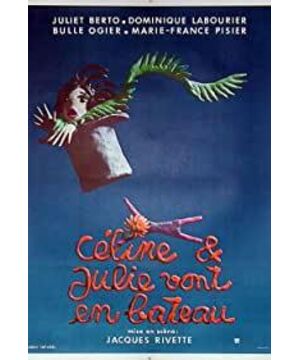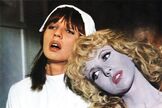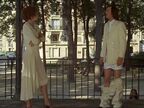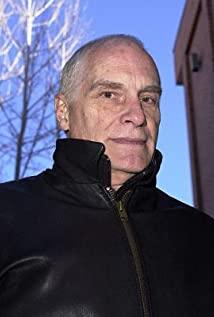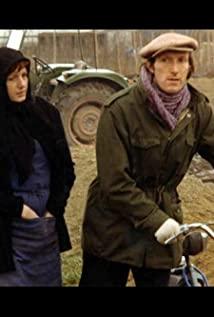Rivett made a story similar to Hitchcock's "Rear Window", except that the protagonist of the audience has changed from a lame man to two lively and romantic women, and the viewing experience is also a projection of male desire. Transform into a surreal dream. At the beginning of the film, there is a chase scene similar to "Vertigo", but the gender of the chaser is changed from a man chasing a woman to a woman chasing a woman. This fragment is confusing: Why didn't Julie just leave Celine behind? give her something back? Instead, they played a game of cat and mouse with her. Did they know each other before? In the ambiguous and frivolous eyes and demeanor, there seems to be a mysterious thread pulling the two unfamiliar souls. The film does not give an explanation until the end: that is, the chase itself is a dream, and the person chasing has appeared in his dream. In Vertigo, the detective chasing a beautiful woman is also a dream, but a dream with male desire. On the other hand, the chase in "Voyage" is fantastic, with childlike innocence and romance. It is an encounter between two people who believe in fate.
Leaving aside ideological interpretations such as "feminism," the form of the film itself is fascinating. It was a documentary style at the beginning, and when the gentle and soft sunlight fell on the neat and delicate French streets and gardens, it was once thought to be the illusion of a Rohmer movie. After Julie entered the haunted house, jump cuts began to appear frequently. This jump cut is different from ordinary flashback clips in that it shows the trance memories of the haunted house in Julie's mind in terms of content, but it brings the audience to the effect. Come to the experience of alienation. As seen in the films of Godard and Varda, the jump cut achieves Brecht's "distancing effect". In the plot to satisfy the audience's voyeuristic desire, the jump cut scene is suddenly inserted, so that the audience can be more rational. way to watch a movie, even reminding the audience: this is watching a movie. "Voyage" breaks the audience's "fascinated" viewing experience through the alienation effect, subverts the traditional viewing relationship, and directly points to the exaggerated illusion of "stage play". The two "stage" sequences in the film are typical examples. One is when Celine went to meet Julie's boyfriend. They danced on a circular pavilion (the pavilion can be seen as an open-air stage), talking about memories of the past in a dramatic tone, and the lines seemed to be Romance, in fact exaggerated and empty, here Rivette used a deep focus lens to capture the background of the dance of the two. There are many passers-by watching the performance on the pavilion. It is obvious from the expressions of passers-by that they are not the same. Not extras, but real passers-by, and children even stared directly at the camera. The front and back scenes of the camera create great tension, thus revealing the essence of this seemingly romantic love stage play with a sense of absurd comedy - a performance of hypocrisy and fussing. That is, the foreground is the performance in the movie, and the passers-by in the background tell the audience, "This is just a performance". In the end, Celine took off her boyfriend's pants, which broke the "lie" of romantic love between men and women. The second is the magic show. Celine's obvious erotic uniform and provocative gestures on the stage arouse the desire of the male audience, but the point of view that Rivett has established for us here is from Julie. , and at the same time, between the subjective and objective perspectives, Rivette frequently uses jump cuts to break the male "desire of voyeurism" and fragment the visual experience of this erotic performance.
It can be seen that before the two entered the haunted house, Celine and Julie had always existed on stage as objects to be spied on (Julie later performed instead of Celine), and both of them passively played the roles that men desire. , so Julie shouted to the audience: "You are all voyeurs.". After entering the haunted house, they put on their uniforms and began to play the role of nurses, but found that this could not save the little girl, so they simply gave up "acting" and improvised "dance" on the stage of the haunted house.
One man and three women in the haunted house, except for the little girl's more natural performance, the other three showed an exaggerated pretence when they raised their hands and feet, and it was obvious that they were acting. Celine and Julie did the same at the beginning, with stiff poses and expressions, and the role of nurse symbolized a subordination. At the end of the film, the man and the woman put on makeup directly. The thick powder is like a ghost. The three of them acted out those boring and exaggerated plots as always, but in the end, the arrival of Celine and Julie added to the "stage play". In order to gain vitality, they changed songs when the three danced, and used various props to tease the three of them. In fact, this reveals Rivett's boredom with formulaic dramatic performances, his preference for improvisational performances, and his distaste for stage plays with exaggerated plots, emphasizing his pursuit of cinematic realism.
The structure of "Voyage" is also intriguing. First, it is the nesting of plays within plays, and the second is the interweaving of dreams within dreams. At the end of the film, Celine woke up from the bench, suggesting that everything before was a dream, but then the appearance of Julie pulled the plot back to the beginning of the film, suggesting that this was not only Celine's dream but also Julie's dream, The structure of the film has also changed from a linear narrative to a circle, a reincarnation, which adds a mysterious sense of fate to the encounter between the two and gives the audience a lot of room for association. I personally guess that the director wants to express the film from It was a dream at the beginning, just like the audience watching a movie over and over again, but it was just constantly reincarnated. In the haunted house, there was also a mention of the man and three women repeating one day forever. In fact, the biggest hint is the music of the film. The music played at the beginning of the film is the same music that Julie and Celine are about to enter the haunted house to save the little girl. All in all, Rivett's constant interweaving style between theatre and film, realism and fantasy, is surprising. Especially through alchemy, eating candy to watch movies is very interesting, and it can be regarded as a gift for movie fans.
View more about Celine and Julie Go Boating reviews


